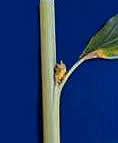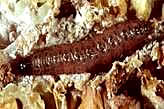Shoot, panicle and capsule borer: Dichocrocis (Conogethes) punctiferalis
| Symptoms of damage: |
- Early stage of the larva bores the unopened leaf buds and feeds on the leaf tissue.
- They also bore the panicles leading to drying up of the portion from the affected spot
- Immature capsules and feed on the young seeds inside rendering the capsules empty.
- Late stage larvae bore the pseudostem and feed the central core of the stem
- Resulting in drying of the terminal leaf and thus produce characteristic 'dead heart' symptom.
- Oozing out of frass material at the point of tunnelling is the indication for the presence of larva inside the plant parts.
- The incidence of this pest is noticed throughout the year but they occur in enormous number in four periods, December-January, March-April, May-June and September-October and their abundance synchronizes with the panicle production, fruit formation and new tiller production.
 |
 |
 |
| Corky encrustations on pods |
Larva |
Adult |
|
| Identification of pest: |
- Egg: is pink, oval, flat and lays singly or in group on the tender part of the plant
- Larva: is long, pale greenish with a pinkish was dorsally, head and pro-thoracic shield brown in colour and body covered with minute hairs arising on wards.
- Pupa: Pupation takes place in lose silken cocoon in larval tunnel.
- Adult: is a medium sized moth; the wings are pale yellowish with black spots on the wings.
|
| Management: |
- During day time adult moths rest on the lower surface of the cardamom. They may be collected with insect net and killed.
- The practice of removing the tillers showing 'dead heart' symptoms should be carried with due care.
- Tillers may be removed if the attack is fresh as indicated by extrusion of frass
- The infestation by early stages of larva of this pest in emerging panicle, immature capsule and leaf bud can be controlled effectively with insecticide application.
- Once the late larvae bore and go deep inside the pseudostem, the chemical spray even in its higher dose becomes ineffective.
|
|



